An extensive new study reveals the growing positive economic impact of operations conducted by U.S. Department of Energy’s Fermi National Accelerator Laboratory in Illinois and South Dakota, contributing $1.6 billion in economic output in fiscal year 2022 and supporting 7,242 jobs.
The FY22 study shows that Fermilab creates positive direct economic impacts in Illinois and South Dakota, as well as beneficial ripple effects within the states’ economies that spark further business-to-business and consumer spending.
Fermi Research Alliance manages and operates Fermilab on behalf of the U.S. Department of Energy. Fermilab is America’s premier particle physics and accelerator laboratory. Scientists from around the world come to use Fermilab facilities for research into the fundamental building blocks of the universe.
In Fermilab’s home state of Illinois, the study shows spending by the laboratory to be a major contributor to the state’s prosperity. Investments in scientific research and spending on operations added nearly $1.3 billion to the state’s economic output in FY22 and increased total household income in Illinois by $529 million.
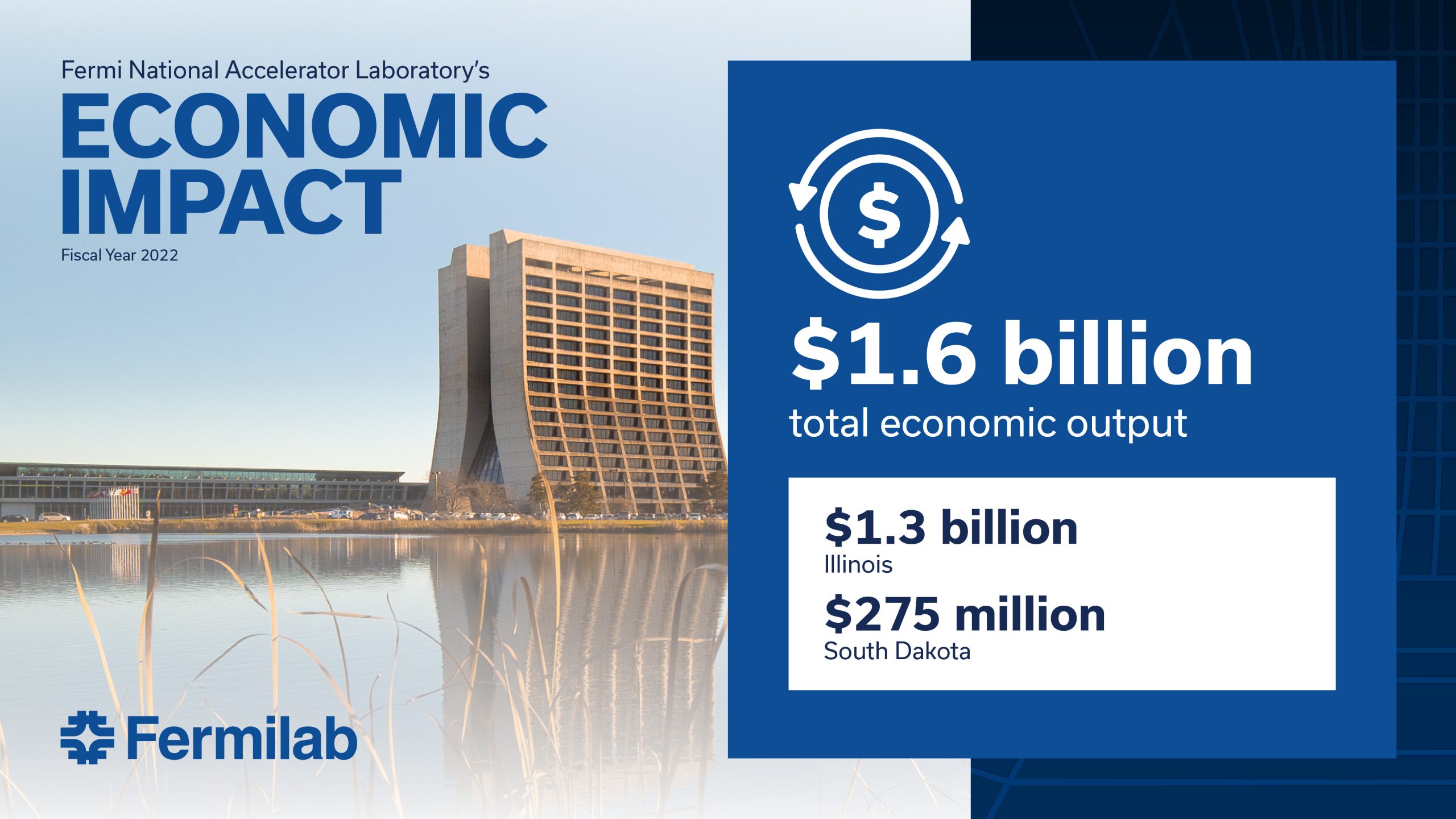
The study further shows laboratory spending to be an engine powering employment in Illinois, accounting for the creation and sustainment of over 5,000 jobs within the state. The total includes more than 1,900 employees at the Fermilab site in Batavia and over 3,000 additional people employed to support Fermilab operations and employees.
Illinois businesses increasingly capitalized on procurement spending, receiving 33% of the $286 million in new subcontract awards. Fermilab’s total economic output in Illinois increased by 188%, driven largely by this more than 50% increase in procurement spending.
The state of South Dakota also received significant economic benefits from laboratory investment during FY22 as excavation and engineering activities were underway to expand caverns at the Sanford Underground Research Facility in Lead, South Dakota.
The seven-story tall caverns, completed in January 2024, will eventually hold massive particle detectors for the Long Baseline Neutrino Facility/Deep Underground Neutrino Experiment project at SURF.
The detectors will be part of an ambitious experiment to study neutrinos, particles which may hold the key to understanding why matter exists in the universe.
During FY22, LBNF/DUNE was the Department of Energy’s largest capital asset project. Fermilab spent $150 million that fiscal year creating this unique, world-class facility.
The economic ripple effect of laboratory spending in FY22 generated $275 million in total economic output, created or sustained 1,500 jobs, and increased household income by $98 million in South Dakota.
Of these jobs, about one thousand were directly connected with project operations, more than 200 were indirect jobs created or sustained through hiring subcontractors, and over 300 jobs were induced by spending from project employees.
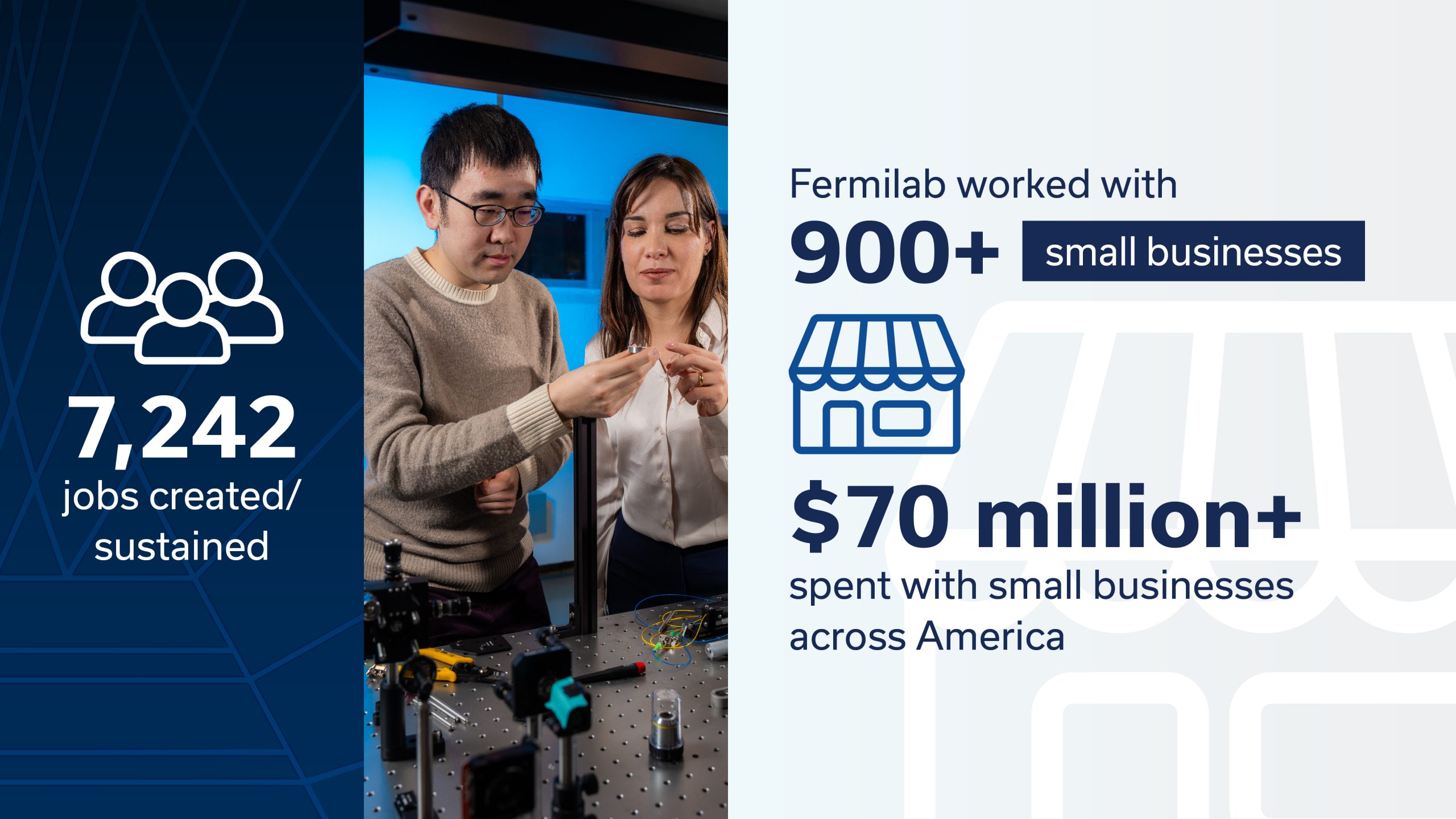
While the LBNF/DUNE excavation occurred in South Dakota, the study points out many of the staff supporting the project in FY22 were subcontractors and/or were operating remotely from Illinois.
In addition to economic gains through spending on operations, engineering and construction projects, Fermilab attracted more than 5,600 visiting professionals to its sites in Illinois and South Dakota.
Fermilab welcomed over 5,000 visiting professionals —an increase from 2,000 in FY18 — to Illinois during FY22 for collaboration on cutting-edge physics experiments. Visitors included scientists, engineers, computing professionals, students, post-doctoral researchers and businesspeople contributing to sustain a thriving research ecosystem.
According to the study, these visitors came to Fermilab in Illinois at an average rate of 170 per week, and they each stayed in the area an average of six days. Each visitor spent an average of $223.54 per day into the local economy.
South Dakota operations attracted more than 600 visiting professionals from outside the state in FY22. Based on survey responses received, people visiting the SURF site spent an average of $172.56 per day into the local economy.
Additionally, the positive economic effects of laboratory spending created benefits to U.S. states beyond Illinois and South Dakota. The study shows businesses and subcontractors across the country were recipients of lab procurement spending in FY22, receiving a total of about $286 million — an increase from $184 million spent in FY18.
A detailed interactive map of the U.S. on the Fermilab website demonstrates how new procurement dollars were spread across a wide range of states.
Of the subcontractors located across America, over 900 were small businesses that received a total of over $70 million. Illinois small businesses received a significant portion of this money — $41 million — from the lab, showing an increase from $34 million in FY18.
Nationwide, 16% of the lab’s procurement spending went to small and disadvantaged businesses, 12% went to woman-owned businesses, 9% to Historically Underutilized Business Zone businesses, and 5% to veteran-owned small businesses.
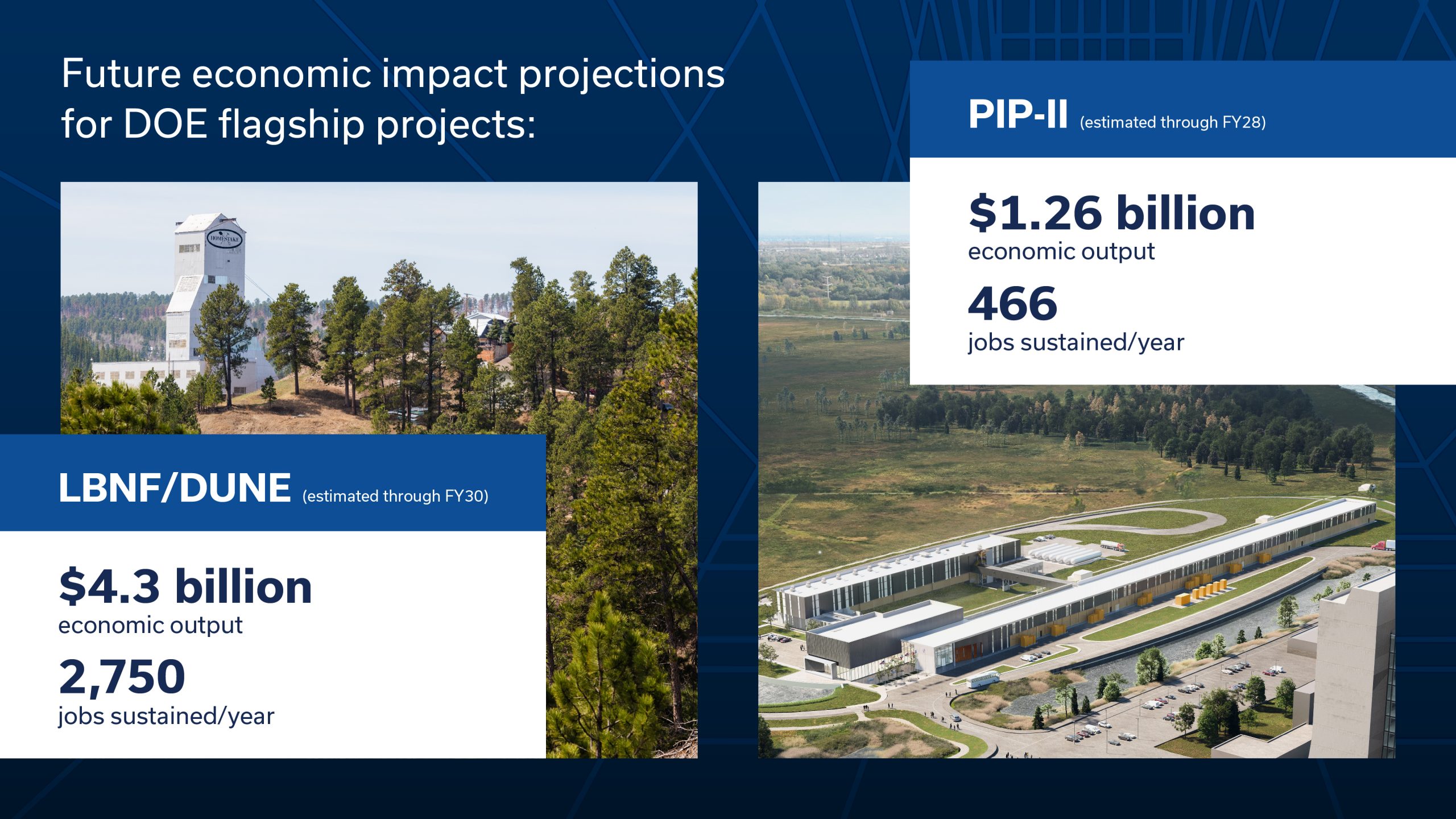
Looking to the future, LBNF/DUNE and the related Proton Improvement Plan-II will continue to be flagship projects, driving advancements in high-energy physics and accelerator science for years to come.
When completed, the new PIP-II particle accelerator will provide an initial stream of protons to the LBNF beam line that will in turn generate the high-intensity beam of neutrinos sent to the DUNE particle detectors.
Spending on PIP-II is forecast to continue through FY28, peaking during FY24—FY25. The total economic output from FY22 to completion in FY28 will generate $1.26 billion in Illinois. During this period the average per-year contributions to the Illinois gross state product will be $70.7 million, with 466 jobs created or sustained annually in Illinois.
Construction-related spending for the LBNF/DUNE project is expected to positively impact economies through FY30. Project-related economic output from LBNF/DUNE is expected to peak during the FY25—FY28 period at $542.9 million annually. Annual employment generated or sustained by LBNF/DUNE is projected to peak during FY25—FY28 with 3,192 jobs.
This study, which assessed the FY22 economic data, used an updated modeling approach to fully capture the extent of economic benefits derived from laboratory operations. Fermilab consulted with other laboratories within the DOE laboratory complex and utilized expertise from Idaho National Laboratory to design and run economic modeling using IMPLAN software.
The software uses a modeling technique called input-output analysis to show how economic activity creates a ripple effect that leads to further economic activity.
This approach captures highly accurate data applicable to the geographic regions in which the laboratory operates and transitions Fermilab to a method of reporting on economic activity that aligns with national laboratory and industry standards.
Fermilab is America’s premier national laboratory for particle physics and accelerator research. A U.S. Department of Energy Office of Science laboratory, Fermilab is located near Chicago, Illinois, and operated under contract by the Fermi Research Alliance LLC. Visit Fermilab’s website at www.fnal.gov and follow us on Twitter at @Fermilab.
The DOE Office of Science is the single largest supporter of basic research in the physical sciences in the United States and is working to address some of the most pressing challenges of our time. For more information, please visit science.energy.gov.
Inventors, creators and entrepreneurs at the U.S. Department of Energy’s Fermi National Accelerator Laboratory were recognized for their inventions and novel ideas by Fermilab’s Office of Partnerships and Technology Transfer at the 2024 Inventor Recognition Ceremony on Feb. 29.
In 2023, 12 new patents were issued with 16 inventors associated with those patents at Fermilab.
“The first U.S. patent granted to an employee of the National Accelerator Laboratory was awarded to Quentin A. Kerns on Jan. 25, 1972; Patent No. 3,638,127, titled ‘Stabilization System for Resonant Cavity Excitation,’’’ said Cherri Schmidt, manager of the Office of Partnerships and Technology Transfer at Fermilab. “We have continued to build on the shoulders of these early inventors to continuously improve accelerator and detector technologies to advance our science.”
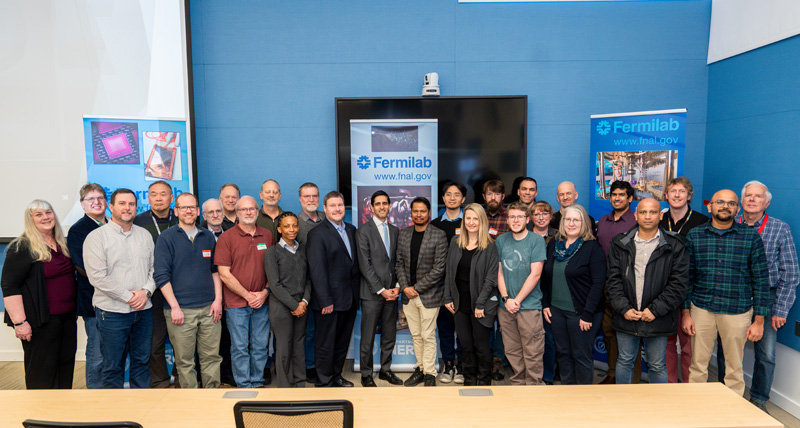
Fermilab inventors, creators and entrepreneurs are honored at the 2024 Inventor Recognition Ceremony on Feb. 29. Photo: Dan Svoboda, Fermilab
The patent awardees from 2023 recognized at the ceremony included:
- James Hoff with co-inventors Sadeep Miryala and Gregory Deptuch, both formerly at Fermilab and now at Brookhaven National Laboratory: Soft error-mitigating semiconductor design system and associated methods
- Timothy Ring: Vertical high-pressure rinse machine
- Alexander Shemyakin and Ding Sun: Fast faraday cup for measuring the longitudinal distribution of particle charge density
- Michael Geelhoed: Electron beam treatment for invasive pests
- Thomas Kroc and Robert Kephart: Inspection system of wellbores and surrounding rock using penetrating X-rays
- Thomas Kroc: Supported X-ray horn for controlling e-beams
- Jin-Yuan Wu: Gated ring oscillator with constant dynamic power consumption
- Sujit Bidhar: Methods and systems for electrospinning using low power voltage converter
- Juan Estrada, Guillermo Fernandez Moroni, Andrew Lathrop and Javier Tiffenberg: Connector interface assembly for enclosed vessels and associated systems and methods
- Tom Zimmerman and Farah Fahim of Fermilab, and Gregory Deptuch — formerly of Fermilab and now at Brookhaven National Laboratory: Compact, low power, high resolution ADC per pixel for large area pixel detectors
Fermilab’s Office of Partnerships and Technology Transfer recognized 50 lab employees who disclosed inventions and software ideas for potential patents. DOE Early Career Awardees Silvia Zorzetti and Guillermo Fernandez Moroni were recognized, as well as other Fermilab employees who received external awards or made out-of-the-box advancements in their fields. Katrina Porter represented the Fermi Site Office for DOE also helped hand out awards.
Guest speakers at the ceremony
Vanessa Chan, chief commercialization officer for DOE and director of the Office of Technology Transitions provided a message through video. “I have so much admiration for the inventors, creators and entrepreneurs at the forefront of fundamental science,” said Chan. “You make the discoveries that so often transform and dramatically improve our quality of life, security and environment. The entire nation, really the entire world, is in your debt.”
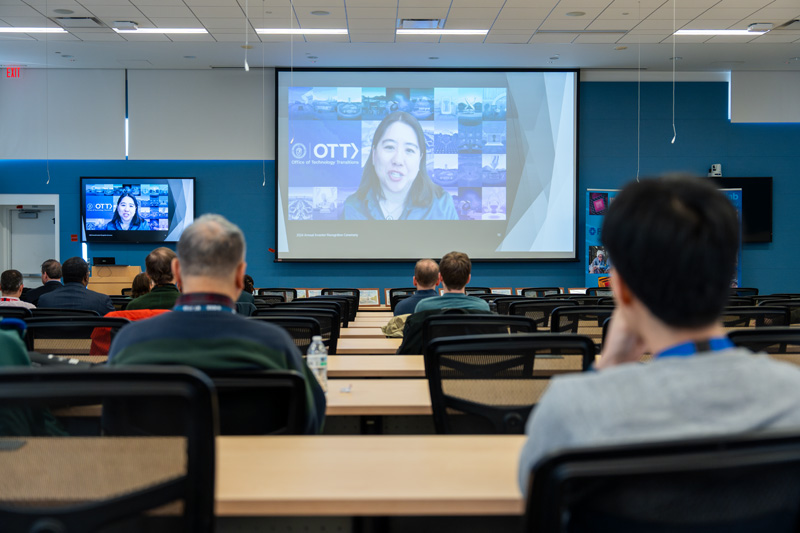
Vanessa Chan from DOE’s Office of Technology Transitions provides remarks during the ceremony. Photo: Dan Svoboda, Fermilab
Chan talked about the importance of training the next generation of scientists and researchers. Some of the examples she included were the Commercialization Internship Program between the national labs, including Fermilab, and her office. Chan also talked about programs that provide undergraduate students with the opportunity to work in quantum science labs through the Chicago Quantum Exchange’s Open Quantum Initiative.
Samir Mayekar, the director of the Polsky Center for Entrepreneurship and Innovation at the University of Chicago, said, “We are advancing the frontiers of science and have a fortress of intellectual property, know-how, engineering and equipment backing us. I believe the wind is at our backs for the first time in generations — perhaps since the founding of the national lab system or the early days of semiconductor developments in Silicon Valley.”
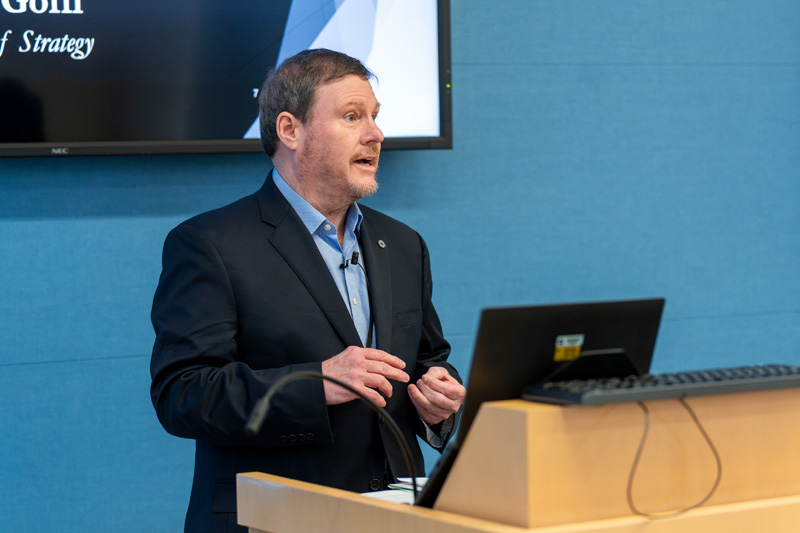
Rich Goffi, director of strategy at Fermilab, speaks to the importance of tech transfer to Fermilab’s mission and future. Photo: Dan Svoboda, Fermilab
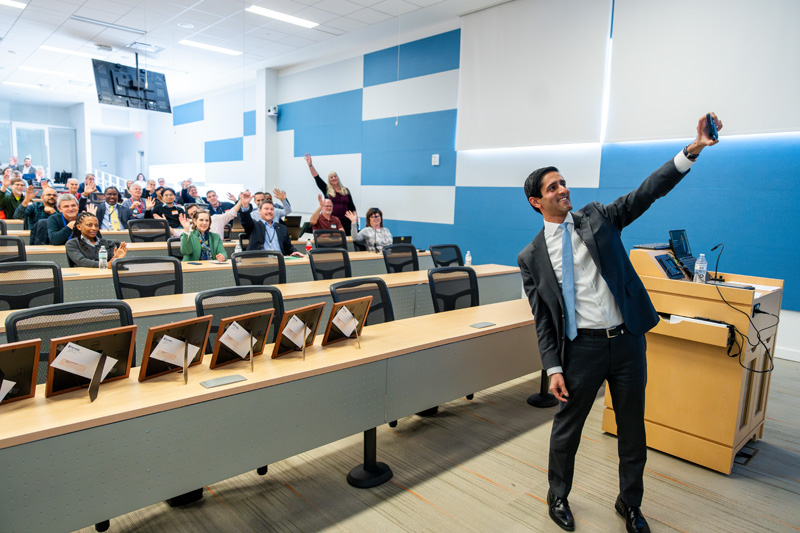
Samir Mayekar snaps a selfie with attendees of the award ceremony. Photo: Dan Svoboda, Fermilab
Fermi National Accelerator Laboratory is supported by the Office of Science of the U.S. Department of Energy. The Office of Science is the single largest supporter of basic research in the physical sciences in the United States and is working to address some of the most pressing challenges of our time. For more information, please visit science.energy.gov.
As part of its Accelerate Innovations program the U.S. Department of Energy is funding three emerging technologies projects involving researchers at its Fermi National Accelerator Laboratory. They are among eleven DOE national lab projects awarded a total of $73 million in funding over a two-year period. The funding aims to speed up the transition of new technology from discovery to industry.
Superconducting photon detector technology
The first project, led by Fermilab, will develop and extend the capabilities of existing superconducting nanowire single-photon detectors, also known as SNSPDs. The technological advances could enable discoveries in fundamental science. Fermilab scientists are particularly interested in using them to expand the search for axions—hypothetical particles that may make up the mysterious dark matter in the universe.
“This work may translate into an enormous scientific opportunity,” said Fermilab’s Si Xie, principal investigator for the project. “Our project and funding are specifically for particle physics applications including dark matter searches. But the result could have wide-ranging impact on diverse fields of science including the search for far away planets, environmental monitoring and climate change applications, and studying some biochemical processes.”
SNSPDs are ultrafast light sensors that use a thin superconducting wire to detect single photons. Scientists operate them at very low temperatures and send an electric current through the wire just below the maximum the superconducting material can withstand without turning normal conducting. When a single photon hits the nanowire, it transfers just enough energy to push the nanowire out of its superconducting state. This causes the material to develop electrical resistance, which creates a measurable voltage pulse.
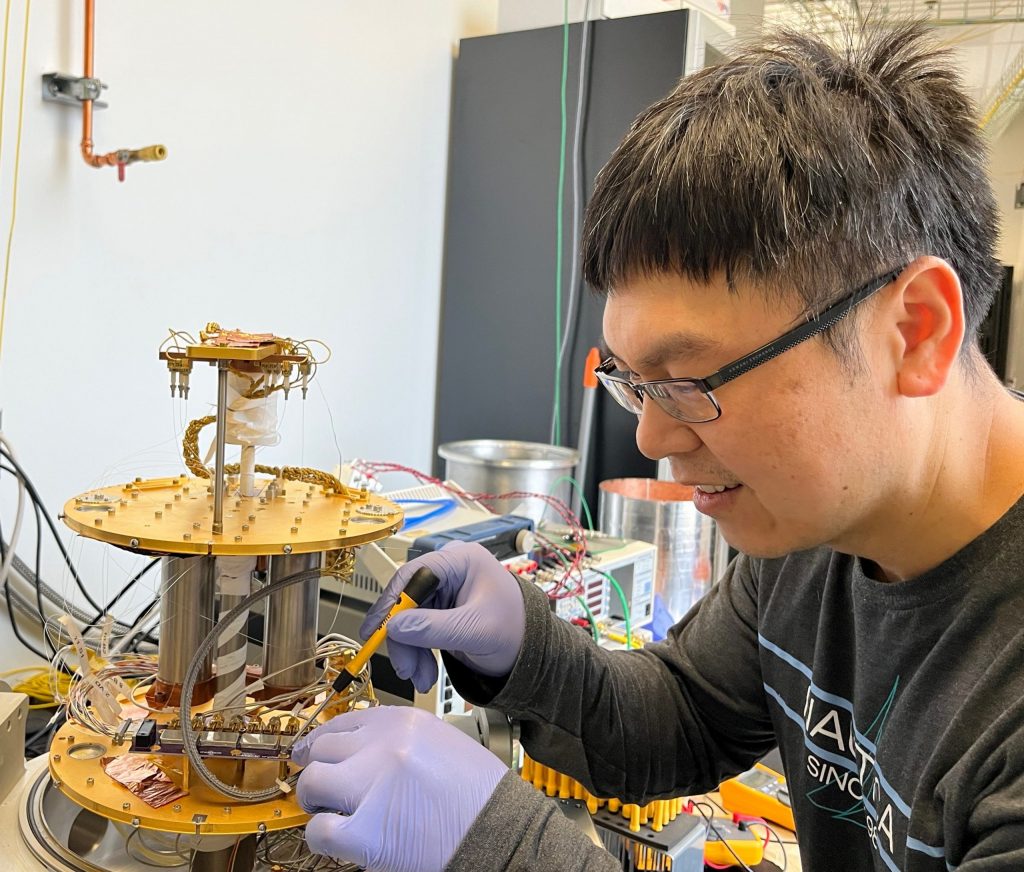
Fermilab scientist Si Xie mounts a superconducting nanowire single photon detector inside a cryostat. He and his colleagues will use the detector to look for light created by dark matter particles. Photo: Christina Wang, Fermilab
The new SNSPD detectors will use very little energy and be ideal for detecting faint photon signals formed by particle interactions that may signal axion existence. The project aims to enable scientists to seek low-energy light from axions with masses in the mid-infrared range, equivalent to 0.05-1 electronvolts. This mass range has remained unexplored so far; no previous detection technology is sensitive enough to such low-energy signals.
To achieve their goal, the project team aims to construct and test prototype detectors with energy thresholds 20 or more times lower than that of conventional SNSPDs. Lower energy thresholds aid in efficient detection of low-frequency, low-energy photons in this range.
As part of their work, the project team will develop specialized antenna structures. These will enable, for the first time, mid-infrared SNSPD detectors with an active sensor area larger than 1 square millimeter. They will also focus on improving the ultrafast signal readout by developing novel sensor electronics that extract and detect particle signals at greater resolution than existing SNSPDs.
Developing 3D integrated sensing solutions
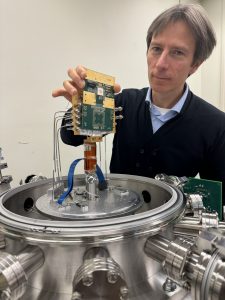
Fermilab project co-lead Davide Braga holds an integrated circuit developed at Fermilab for extreme environment applications. Scientists aim to make this sensor much tinier while increasing its accuracy and timing. Photo: Albert Dyer, Fermilab
Anything using microelectronics today requires a lot of functionality squeezed into a tiny amount of space. This includes particle physics experiments, which need low-power detectors with precision timing and position capabilities and high-throughput readout. Conventional two-dimensional chip technology has reached its limits and can no longer meet the ever more stringent requirements.
To help solve this problem, DOE has funded a new project led by SLAC National Accelerator Laboratory. The project will enable large-scale particle sensors with three-dimensional integrated circuits to process much smaller, much faster signals at a higher level of precision. Fermilab is a major contributor to this project. Artur Apresyan and Davide Braga are the project co-investigators at Fermilab.
The sensors will be part of 3D heterogeneously integrated detectors—essentially stacked wafers, each layer with its own functionality. The wafers are connected at the micrometer scale. This eliminates traditional larger interconnections and significantly improves the fidelity of signals all along the chain.
“You can have a lower power because you are getting signals with low noise, so you can use resources more optimally and you can do a lot more with those resources,” said Apresyan.
While the current generation of this technology uses rather large pixels, around one millimeter, the goal is to scale this down to 50-micron pixels.
“We want to demonstrate 3D integrated sensors that utilize Low Gain Avalanche Detector particle sensors that provide very fast timing information,” said Braga. “We intend to simultaneously achieve 10-micron position resolution and 10-picosecond precision timing while consuming low power and reaching high throughput rates.”
The team is also partnering with a commercial chip company to develop advanced manufacturing capability for this novel technology. Their fabrication know-how will be essential for the codesign of sensor and electronics for scaling, said Braga.
“As we develop the technology to fabricate novel detectors using cutting-edge industrial processes, the partnership will allow us to tap into advanced manufacturing facilities to develop sensors that perform sophisticated operations on the detector itself that were not possible before,” said Apresyan.
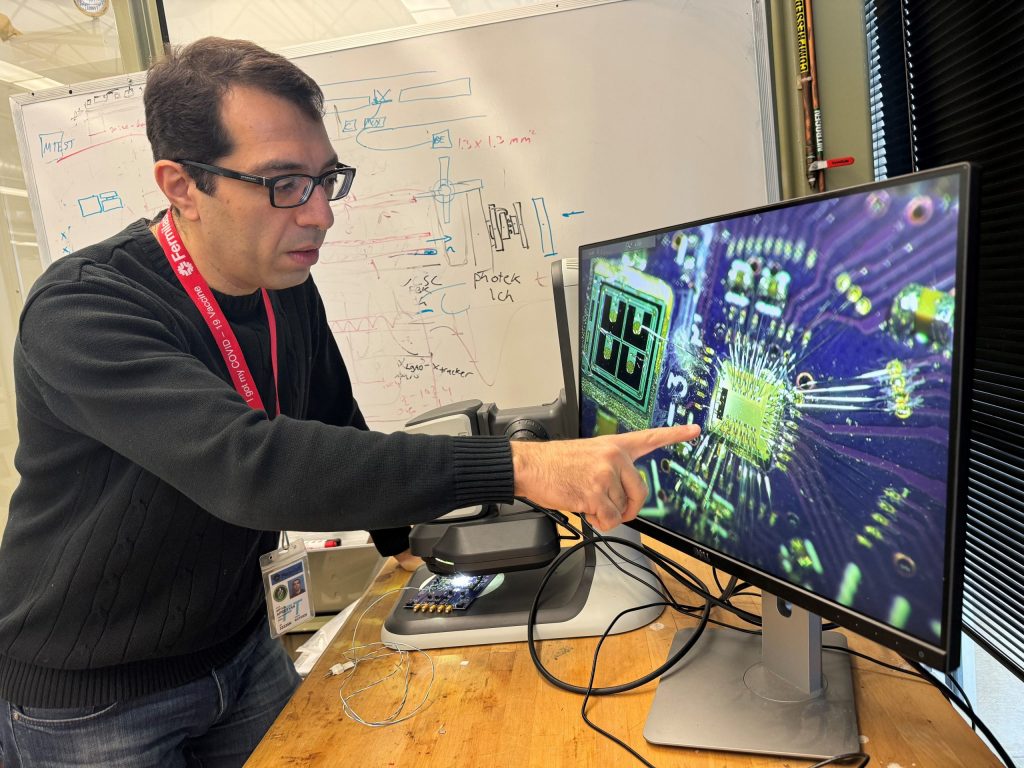
Artur Apresyan inspects the Fermilab-designed integrated circuit that will be used for precision timestamping of signals from silicon detectors. Photo: Cristian Peña, Fermilab
Compact accelerators for industrial applications
The third project is a collaboration between DOE’s Thomas Jefferson National Accelerator Facility and Fermilab. It aims to advance the use of compact superconducting radiofrequency electron-beam accelerator technology for industrial processes. As part of the project, researchers at Jefferson Lab are focusing on further developing the particle accelerator technology. Fermilab will identify industrial applications and develop a technology roadmap to satisfy industrial needs.
“We’re investigating where an electron-beam accelerator could be a good fit and solve problems,” said scientist Slavica Grdanovska, principal investigator at Fermilab for the project. “We’re focusing on industrial processes—where you can maybe substitute conventional technologies with e-beam technology—or see if it can help make their current processes more efficient.”
By organizing a workshop with potential industry partners this spring, the project team aims to identify barriers to implementing this powerful technology.
“At this workshop, we want to show potential industrial partners the current status of our technology, identify processes in the industry where electron beams could make a difference, and focus on specific targets that need to be reached in the accelerator design for use in an industrial setting,” said Fermilab scientist Charles Thangaraj. “We are also seeking potential partners for system integration and production once these machines are ready.”
Fermilab and Jefferson Lab will then hash out the accelerator technology roadmap to reach those targets.
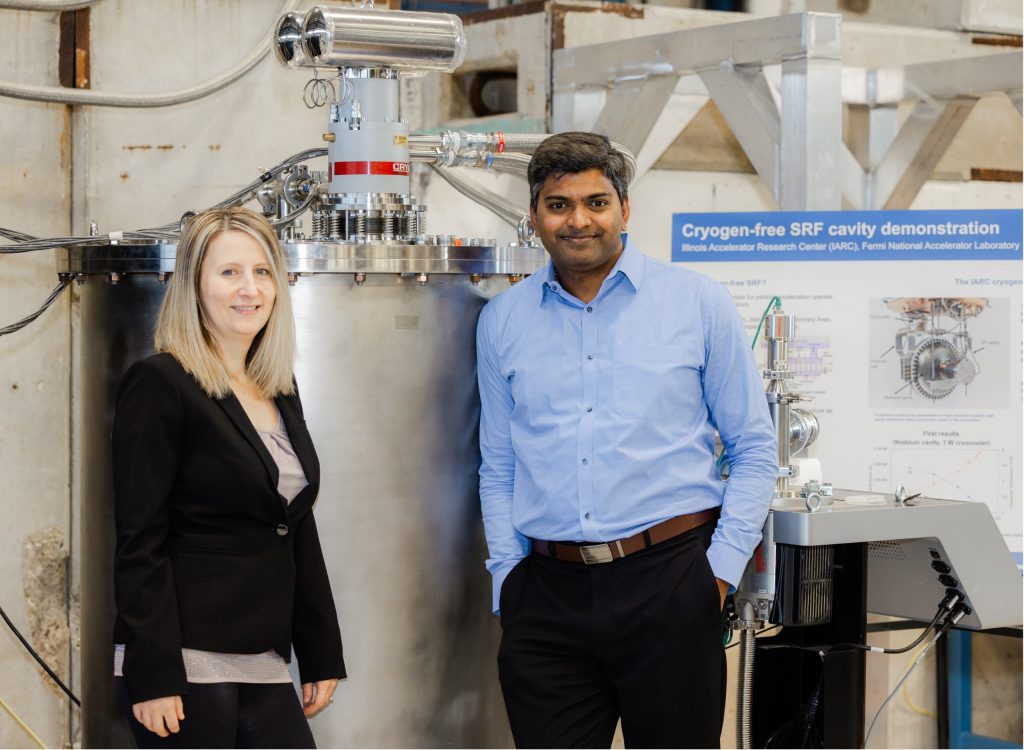
Fermilab scientists Slavica Grdanovska (left) and Charles Thangaraj stand next to the conduction cooled cryostat that houses superconducting accelerator technology for industrial electron beam applications. Photo: Tom Nicol, Fermilab
Fermi National Accelerator Laboratory is supported by the Office of Science of the U.S. Department of Energy. The Office of Science is the single largest supporter of basic research in the physical sciences in the United States and is working to address some of the most pressing challenges of our time. For more information, please visit science.energy.gov.
